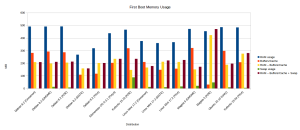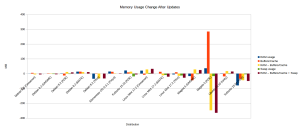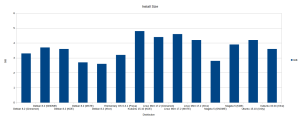It’s been a while but once again here is the latest instalment of the series of posts where I install the major, full desktop, distributions into a limited hardware machine and report on how they perform. Once again, and like before, I’ve decided to re-run my previous tests this time using the following distributions:
- Debian 8.2 (Cinnamon)
- Debian 8.2 (GNOME)
- Debian 8.2 (KDE)
- Debian 8.2 (MATE)
- Debian 8.2 (Xfce)
- Elementary OS 0.3.1 (Freya)
- Kubuntu 15.10 (KDE)
- Linux Mint 17.2 (Cinnamon)
- Linux Mint 17.2 (MATE)
- Linux Mint 17.2 (Xfce)
- Mageia 5 (GNOME)
- Mageia 5 (KDE)
- Ubuntu 15.10 (Unity)
- Xubuntu 15.10 (Xfce)
I also attempted to try and install Fedora 23, Linux Mint 17.2 (KDE) and OpenSUSE 42.1 but none of them were able to complete installation.
All of the tests were done within VirtualBox on ‘machines’ with the following specifications:
- Total RAM: 512MB
- Hard drive: 10GB
- CPU type: x86 with PAE/NX
- Graphics: 3D Acceleration enabled
The tests were all done using VirtualBox 5, and I did not install VirtualBox tools (although some distributions may have shipped with them). I also left the screen resolution at the default (whatever the distribution chose) and accepted the installation defaults. All tests were run prior to December 2015 so your results may not be identical.
Results
Just as before I have compiled a series of bar graphs to show you how each installation stacks up against one another. Measurements were taken using the free -m command for memory and the df -h command for disk usage.
Like before I have provided the results file as a download so you can see exactly what the numbers were or create your own custom comparisons (see below for link).
Things to know before looking at the graphs
First off if your distribution of choice didn’t appear in the list above its probably not reasonably possible to be installed (i.e. I don’t have hours to compile Gentoo) or I didn’t feel it was mainstream enough (pretty much anything with LXDE). As always feel free to run your own tests and link them in the comments for everyone to see.
Quick Info
- Out of the Cinnamon desktops tested Debian 8.2 had the lowest memory footprint
- Out of the GNOME desktops tested Mageia 5 had the lowest memory footprint
- Out of the KDE desktops tested Mageia 5 had the lowest memory footprint
- Out of the Xfce desktops tested Debian 8.2 had the lowest memory footprint
- Out of the MATE desktops tested Debian 8.2 had the lowest memory footprint
- Elementary OS 0.3.1 had the highest memory footprint of those tested
- Debian 8.2 Xfce and MATE tied for the lowest memory footprint of those tested
- Debian 8.2 Xfce had the lowest install size of those tested
- Kubuntu 15.10 had the largest install size of those tested
- Elementary OS 0.3.1 had the lowest change after updates (+2MiB)
- Mageia 5 KDE had the largest change after updates (-265MiB)
First boot memory (RAM) usage
This test was measured on the first startup after finishing a fresh install.
 Memory (RAM) usage after updates
Memory (RAM) usage after updates
This test was performed after all updates were installed and a reboot was performed.
 Memory (RAM) usage change after updates
Memory (RAM) usage change after updates
The net growth or decline in RAM usage after applying all of the updates.
The hard drive space used by the distribution after applying all of the updates.
Once again I will leave the conclusions to you. Source data provided below.
Source Data



Hello,
You have obtained interesting results;
Thank you for your time & efort!
I used to test myself some Linux distro, and I would like to try to include in your test other interesting distros:
Arch with XFCE,
Manjaro with XFCE
LXLE.
IMHO Fedora could be excluded, as heavy RAM consumer distro.
Thank you again,
Adrian
@Adrian
The reason for including the “heavy” distros is precisely to see how they act in a restricted environment. Obviously there are leaner distros to consider using when in such a constrained environment and you mentioned a few. 🙂
You can install opensuse but with the CLI installer and use Tumbleweed since Leap doesn’t support 32 bits anymore